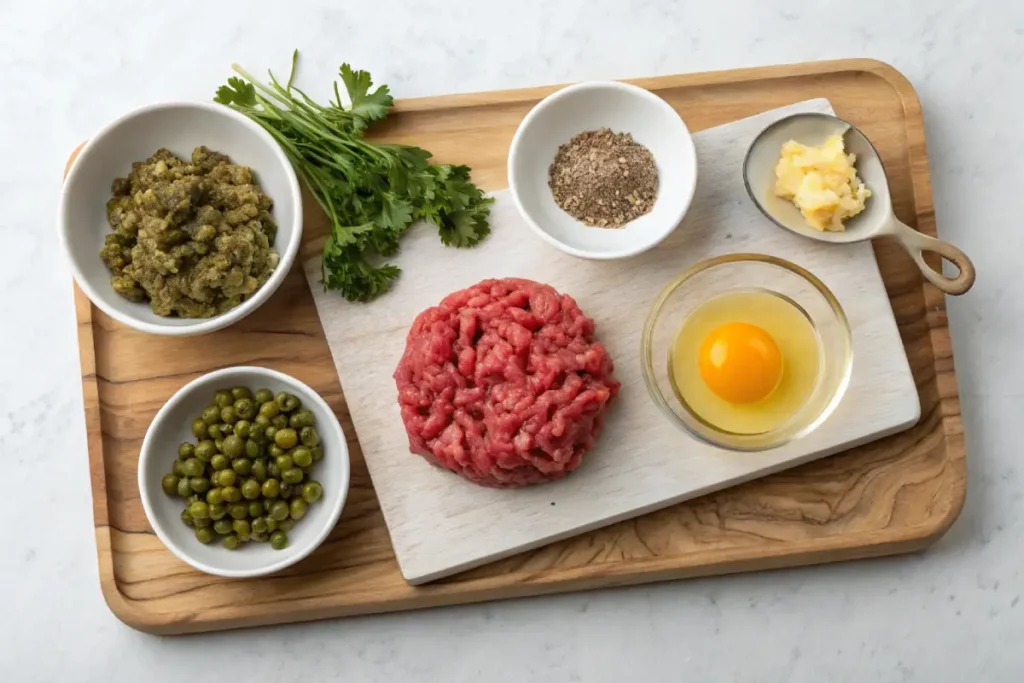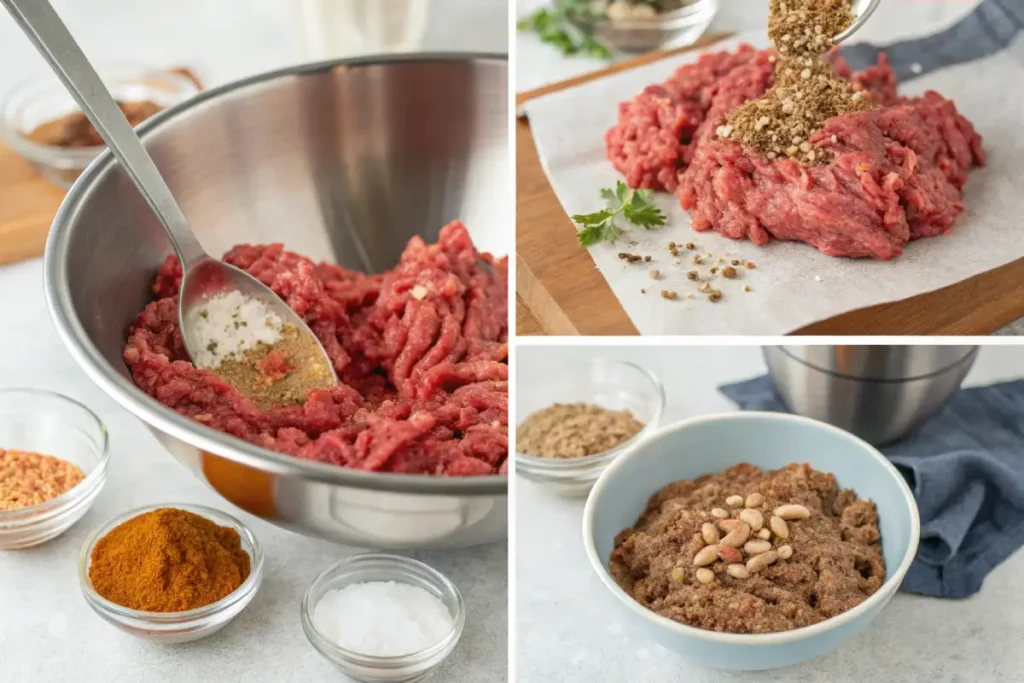Introduction
So, what is beef tartare? If you’ve ever been curious about that fancy-sounding dish you see on upscale menus, you’re not alone. Picture this: a plate of finely chopped raw beef, perfectly seasoned, and served as a light, refreshing dish that’s as elegant as it is simple. At first, the idea of eating raw beef might seem intimidating (I mean, we’re all used to cooking everything, right?), but trust me, beef tartare is one of those recipes that feels like a little culinary adventure. Plus, it’s surprisingly easy to make at home!
Now, here’s why you’re going to love this dish—it’s customizable, packed with flavor, and doesn’t take much time to prepare. Whether you’re serving it as an appetizer for guests or treating yourself to a fancy night in, it’s always a winner. Keep reading, and I’ll show you everything you need to know!
Table of Contents
A Brief History of Beef Tartare
The Origins of Beef Tartare in Culinary Traditions
Beef tartare has roots that go way back in history. It’s believed to have originated from nomadic tribes in Central Asia. These people, known as the Tatars, reportedly used to tenderize meat by placing it under their saddles while riding. That’s a pretty wild way to prepare food, don’t you think? Eventually, this method evolved into a raw meat dish that gained popularity for its simplicity and flavor. Over time, French chefs adopted it and added their own touches, turning it into the gourmet dish we know today.
To learn more about how beef dishes are innovatively presented, check out beef heart recipes, where traditional techniques meet unique culinary ideas.
Here’s what makes it unique: beef tartare doesn’t rely on heat. Instead, it’s all about the quality of the meat and the perfect balance of seasonings. From its humble beginnings, this dish has grown into a symbol of sophisticated dining.
| Quick Facts | Details |
|---|---|
| Origin | Central Asia (Tatar Tribes) |
| Popularization | French Culinary Influence |
| Preparation Style | Raw and finely chopped meat |
How Beef Tartare Became a Global Delicacy
Beef tartare didn’t stay hidden in Europe for long. By the early 20th century, it had made its way to menus worldwide, thanks to its elegant presentation and bold flavors. Its rise in fine dining circles was unstoppable. Chefs loved it for its ability to showcase the meat’s natural taste. Diners, on the other hand, enjoyed the novelty of eating something raw yet luxurious.
Now, you’ll find beef tartare in fancy restaurants from Paris to New York City. In addition, each region has its own spin on it. Some serve it with egg yolks on top, while others add spices or herbs for a unique twist. This dish is no longer just about tradition—it’s about creativity.
| Country | Style of Serving |
|---|---|
| France | Classic with capers and onions |
| Italy | Includes truffle oil |
| Japan | Features soy and sesame |
Understanding the Components of Beef Tartare
Key Features That Define a Classic Beef Tartare
A classic beef tartare isn’t just raw beef thrown on a plate—it’s carefully crafted to balance flavor, texture, and presentation. The star ingredient is high-quality beef, typically a lean cut like tenderloin. It’s finely chopped or minced to achieve a smooth texture that melts in your mouth.
If you’re curious about other exciting beef-based creations, explore this guide to beef arm roast recipes for hearty and flavorful meal ideas.
The seasoning is what brings everything together. Common additions include finely chopped onions, capers, Dijon mustard, and a hint of fresh parsley. Each ingredient has a role to play. The capers add a tangy kick, while mustard provides a subtle sharpness. Finally, it’s usually topped with a raw egg yolk for extra richness.
If you’re making it at home, remember that freshness is non-negotiable. You want every ingredient to taste as clean and bright as possible.
| Essential Components | Purpose |
|---|---|
| High-quality beef | Base flavor |
| Capers and onions | Adds tang and crunch |
| Raw egg yolk | Rich, creamy texture |

How Freshness Impacts the Flavor and Texture
Freshness is everything when it comes to beef tartare. First, the beef needs to be incredibly fresh to ensure a safe and flavorful dish. Fresh meat not only tastes better but also has a tender texture that’s perfect for raw preparation.
Next, the ingredients you mix in also need to be fresh. Crisp onions, fresh herbs, and even the egg yolk all contribute to the dish’s overall taste. Without freshness, the dish can fall flat or taste unbalanced.
- Why Freshness Matters:
- Ensures the best flavor
- Keeps the texture smooth and tender
- Reduces risk of foodborne illness
- Tips for Maintaining Freshness:
- Buy beef from a trusted source
- Use the ingredients within 24 hours
- Store everything properly in the fridge
Variations and Regional Twists
Popular Beef Tartare Styles from Around the World
Beef tartare is a dish that invites creativity, and every region has its take on it. In France, you’ll find the classic version with onions, capers, and mustard. Italy adds its signature flair with a drizzle of olive oil and truffle shavings. Meanwhile, in Asia, flavors like sesame oil and soy sauce bring a new dimension to the dish.
Another interesting twist comes from Mexico, where chefs might mix in fresh lime juice and spicy peppers. Even the way it’s served varies. Some regions offer it with toast points or crackers, while others prefer to keep it minimalist.
| Region | Key Ingredients |
|---|---|
| France | Capers, mustard, onions |
| Italy | Olive oil, truffles |
| Mexico | Lime juice, chili peppers |
Creative Ingredient Swaps to Suit Different Diets
Beef tartare doesn’t have to stick to tradition. You can tweak the recipe to fit different preferences or diets. For instance, instead of beef, you can try tuna for a seafood twist. Vegetarians can even use finely chopped mushrooms or beets for a plant-based version.
- Ingredient Ideas for Swaps:
- Tuna or salmon for seafood lovers
- Mushrooms for a hearty, vegetarian option
- Beets for a colorful, plant-based take
These swaps not only keep the dish interesting but also make it accessible to more people.
How to Safely Prepare Beef Tartare at Home
Choosing the Best Cuts of Beef for Beef Tartare
When preparing beef tartare, the cut of beef is crucial. You want something lean and tender, like beef tenderloin or sirloin. These cuts are perfect because they don’t have too much fat or connective tissue, which can make the texture less enjoyable.
First, buy your beef from a trusted butcher. Let them know you’ll be using it for tartare so they can recommend the freshest option. Then, trim away any excess fat or sinew before chopping it finely.
For best results, chill the beef slightly before cutting. This makes it easier to handle and helps maintain its clean, smooth texture.
| Recommended Cuts | Why They Work |
|---|---|
| Tenderloin | Lean and tender texture |
| Sirloin | Balanced flavor and texture |
Tips for Proper Handling and Safe Preparation
Preparing beef tartare safely isn’t difficult, but it does require a little extra care. First, always work with clean tools and surfaces. This reduces the risk of contamination.
Next, keep the beef cold from start to finish. Cold temperatures slow down bacteria growth and keep the meat fresh. If you’re adding raw egg yolk, make sure it’s from a safe, pasteurized source.
- Safety Tips:
- Wash your hands and utensils thoroughly
- Use a food thermometer to check the meat’s temperature
- Consume immediately after preparation
| Do’s | Don’ts |
|---|---|
| Use fresh, high-quality beef | Leave beef at room temperature |
| Chill meat before chopping | Skip washing utensils |
Now that you know all about beef tartare’s history, flavors, and variations, it’s time to roll up your sleeves and bring this dish to life—let’s get chopping!
Beef Tartare: A Classic Dish with a Modern Twist
Introduction
Beef tartare might sound fancy, but trust me, it’s surprisingly simple to make at home! This dish is all about fresh, high-quality ingredients coming together in the best way possible. It’s rich, flavorful, and perfect as a starter or even a light meal. Plus, with a few small tweaks, you can customize it to suit your style. Let’s get you slicing, mixing, and plating like a pro—don’t worry, it’s way easier than it looks!
Ingredients
Let’s talk about the stars of this dish! Each ingredient has its own unique role, and together they create magic on your plate. Here’s what you’ll need to make beef tartare:
- Beef filet (300 g or 10.6 oz): This is the foundation of the dish. Use the freshest, high-quality filet for the best results. First, you can mince it with a knife for a classic texture or use a food grinder if you prefer speed.
- Egg yolk: This creamy gem adds richness and helps bind the flavors together. It’s like the glue that holds the dish.
- Dijon mustard (1 tsp): A little tang and sharpness go a long way. Dijon mustard gives your tartare that classic zippy kick.
- Olive oil (40 ml or 1.35 fl oz): Smooth and flavorful, olive oil adds richness to the dressing and balances the other ingredients.
- Shallots (2 ½ tbsp, finely diced): These add a subtle sweetness and crunch, giving the tartare a balanced texture.
- Parsley and chives (2 tsp each, finely chopped): These fresh herbs bring brightness and a hint of earthy flavor to the dish.
- Capers (1 tsp, roughly chopped): These tiny flavor bombs add a salty, briny punch that pairs perfectly with the beef.
- Tomato ketchup (1 tsp): Yes, ketchup! It adds a slight sweetness and just enough acidity to round out the flavors.
- Gherkins (1 tsp, chopped): Crunchy and tangy, these little pickles add a fun texture and a touch of sharpness.
- Tabasco (a few drops): A splash of heat makes the flavors pop, but don’t overdo it unless you love spice!
- Soy sauce (a few drops): This is a great alternative to Worcestershire sauce, adding depth and umami without any alcohol.
- Salt and pepper: The final seasoning duo brings everything together. Add to taste, but don’t forget to taste as you go!
Step-by-Step Instructions
1. Prepare Your Beef
Start by chilling your beef filet in the refrigerator to keep it fresh and firm. Next, mince the meat finely with a sharp knife or use a food grinder. Keeping it cold is key—it ensures the best texture and flavor for your beef tartare.
2. Make the Dressing
In a small bowl, whisk the egg yolk with the Dijon mustard until smooth. Then, slowly drizzle in the olive oil while whisking. This will create a creamy, rich dressing that’s packed with flavor.
3. Add the Flavors
Now, mix in the shallots, parsley, chives, capers, ketchup, chopped gherkins, Tabasco, and soy sauce. Stir well to combine everything evenly. Don’t forget to add salt and pepper to taste—it makes all the difference!
4. Combine Everything
Take your chilled minced beef out of the fridge and place it in a large bowl. Pour the dressing over the beef and gently mix it together. Be careful not to mash the meat—you want it to stay light and airy.
5. Plate and Serve
Shape the tartare into a neat mound or use a round mold for a professional look. Serve immediately with crispy bread, crackers, or even a fresh side salad. It’s time to dig in and enjoy your homemade beef tartare!

Serving
This recipe serves two people generously or four as an appetizer. To serve, place the beef tartare on individual plates or a shared platter. You can pair it with:
- Toasted bread slices for crunch and contrast.
- A simple side salad with a light vinaigrette to balance the richness.
- Add extra garnishes like chopped chives, parsley, or even a sprinkle of smoked paprika for color.
For a fun twist, try serving it with thinly sliced cucumber or radish for an extra fresh bite.
Tips and Hacks
- Use the freshest beef possible: Buy from a trusted butcher and grind it yourself if you can. Freshness is key.
- Chill everything: Keep the beef and even your bowl cold while preparing to maintain the best texture.
- Adjust the spice level: Add more Tabasco if you love heat, or leave it out if you don’t.
- Try ingredient swaps: For a milder flavor, swap Dijon mustard with whole-grain mustard.
- Storage tip: Beef tartare is best eaten fresh. If you have leftovers, store them in an airtight container for no more than 24 hours.
Nutrition Facts
Serving size: 150 g
- Calories: 340
- Fat: 24 g
- Carbs: 3 g
- Protein: 30 g
- Sodium: 420 mg
- Fiber: 1 g
Please note: Nutrition facts are estimates based on standard portion sizes and may vary depending on ingredient brands and preparation methods.
Prep Time
- Prep time: 15 minutes
- Cook time: 0 minutes (no cooking needed!)
- Total time: 15 minutes
Note: Prep time includes chopping, mixing, and plating. It’s quick and easy, but worth every minute!
Frequently Asked Questions (FAQs)
Is beef tartare completely raw?
Yes, beef tartare is completely raw, but don’t let that scare you! The secret lies in using the freshest, high-quality beef available. First, it’s finely minced or chopped to create a tender texture. Then, it’s mixed with flavorful seasonings and ingredients that bring the dish to life. While it’s raw, the freshness and balance of flavors make it an exciting culinary experience.
What is the parasite in steak tartare?
The parasite people worry about in raw beef is typically a microscopic organism like Toxoplasma gondii. But don’t panic! Using fresh, high-quality beef from a trusted source significantly reduces any risk. First, avoid using pre-ground meat, which can have more bacteria. Also, freezing the beef beforehand can kill many parasites. With the right precautions, steak tartare can be both safe and delicious to enjoy.
How do I make sure my steak tartare is safe?
Safety starts with high-quality, fresh beef from a reliable butcher. First, tell your butcher you’re making beef tartare to get their best recommendation. Next, keep everything cold while preparing the dish, including the beef and mixing bowl. Then, use clean tools and wash your hands often. If you’re adding a raw egg yolk, make sure it’s pasteurized. With these steps, your dish will be both safe and tasty!
Is beef tartare mince?
Yes, beef tartare is typically made from minced or finely chopped beef, but it’s not your average mince! The meat is either hand-chopped or ground to create a smooth, tender texture. It’s also seasoned with a mix of flavorful ingredients, like mustard, herbs, and capers. So, while it’s technically minced, beef tartare is in a league of its own when it comes to flavor and presentation.
Conclusion
A Timeless Dish Worth Trying at Home!
Now that you know what beef tartare is, why not give it a try at home? This dish combines simplicity with elegance, making it a fun way to impress yourself or others. First, it’s all about using the freshest ingredients. Then, with just a few easy steps, you can create something truly special.
The best part? You can adjust it to suit your taste. Add a little more spice, switch up the herbs, or pair it with your favorite sides. If you’re looking to pair it with a comforting classic, consider trying this beefaroni recipe—a hearty dish that complements the rich flavors of tartare.
So, whether you’re hosting a dinner party or just treating yourself, beef tartare is a recipe worth trying. It’s fresh, flavorful, and totally unforgettable. Go ahead, grab your ingredients, and start chopping! You’re going to love this timeless classic—it’s like a mini adventure on your plate!
